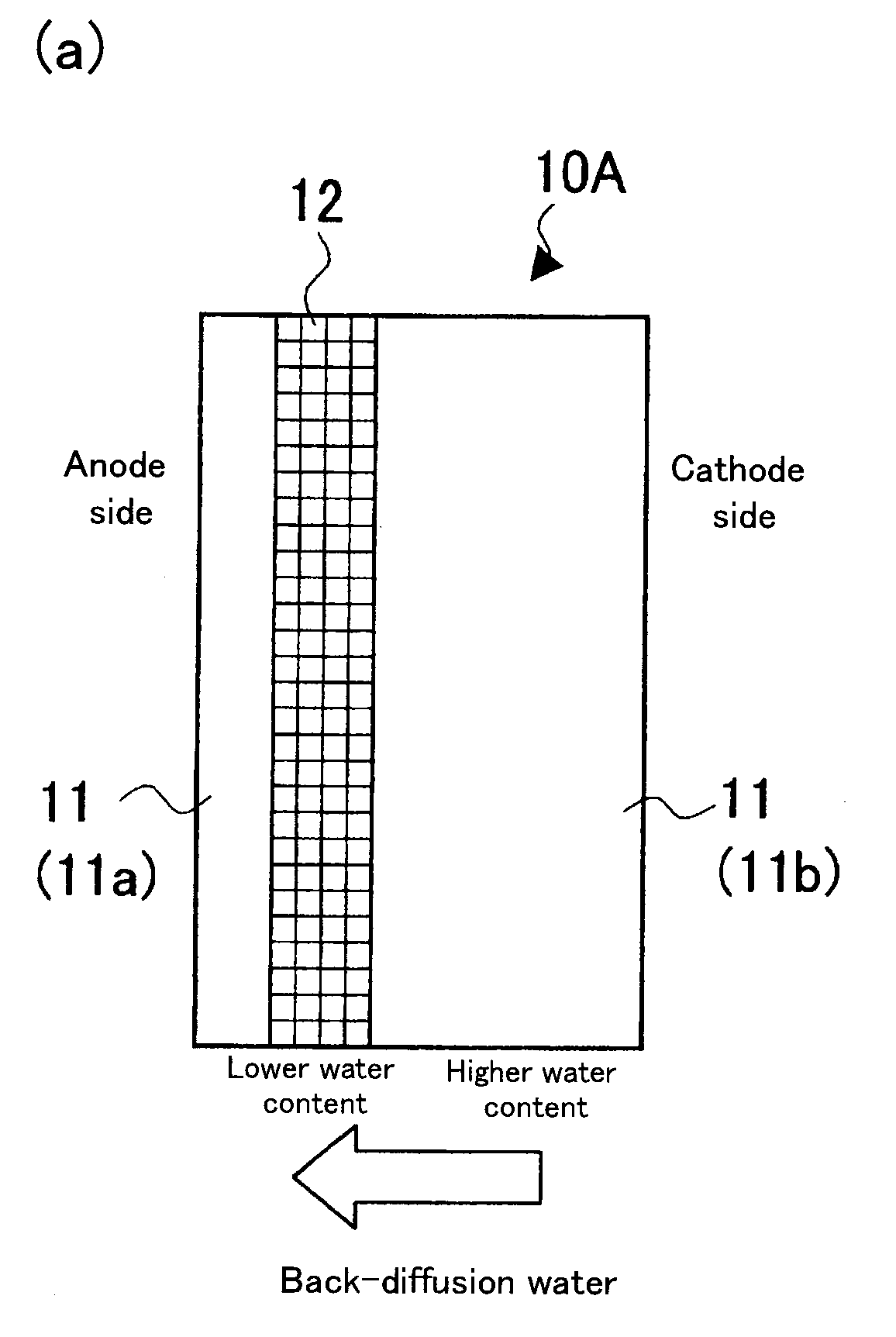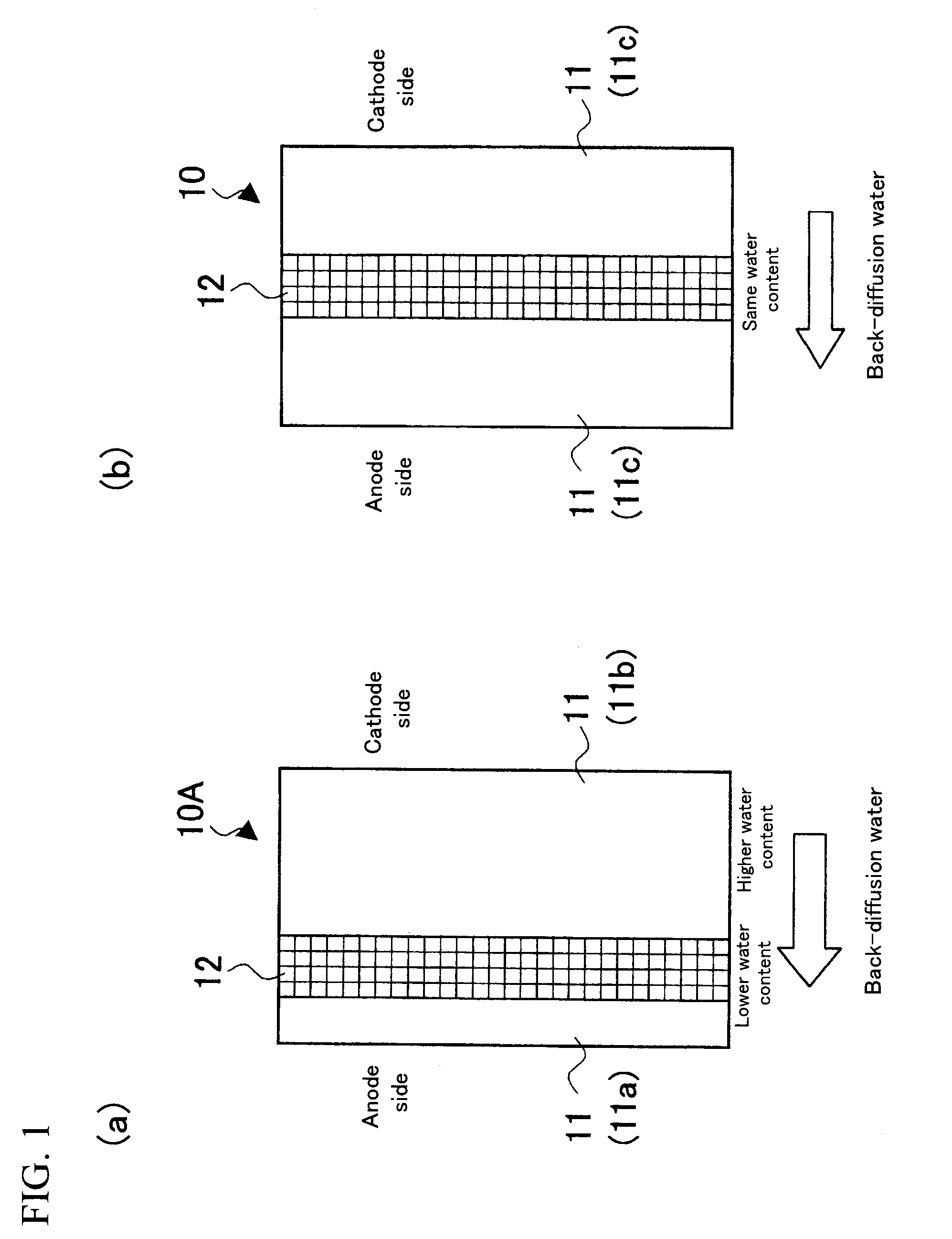Electrolyte membrane and fuel cell using the same (as amended)
a technology of electrolyte membrane and fuel cell, which is applied in the direction of fuel cells, composite electrolytes, electrochemical generators, etc., can solve the problems of significant reduction in power generation performance, significant decline in cell performance, and decline of proton conductivity, so as to increase the water absorbing capacity of the cathode side, the effect of low humidification operation
- Summary
- Abstract
- Description
- Claims
- Application Information
AI Technical Summary
Benefits of technology
Problems solved by technology
Method used
Image
Examples
example 1
[0048](1) PTFE was expanded in two axis directions to prepare a first expanded porous reinforcing membrane 12a of a resin equivalent tensile strength of 200 Mpa and a porosity of 60%, and a second expanded porous reinforcing membrane 12b of a resin equivalent tensile strength of 100 Mpa and a porosity of 80%.
[0049](2) A solution of electrolyte resin (“DE2020”, a polymeric solution manufactured by DuPont, whose polymer-chain ends are —SO3H) was poured onto a first porous reinforcing membrane 12a placed on a glass substrate; a second porous reinforcing membrane 12b was placed thereon; and further the aforementioned solution of electrolyte resin was poured thereto. The mixture was dried at 70° C. for 1 hour to obtain a reinforcing-membrane-type electrolyte membrane having a configuration shown in FIG. 2(a) and a thickness of about 30 μm.
example 2
[0050](1) Expanded porous reinforcing membranes 12a and 12b similar to those of Example 1 were prepared.
[0051](2) Precursor resin of electrolyte resin (“NE111F”, a polymer manufactured by DuPont, whose polymer-chain ends are —SO2F) was extruded by an extrusion machine to obtain a thin membrane of a thickness of about 8 μm.
[0052](3) Three sheets of the aforementioned electrolyte resin precursor thin membranes and expanded porous reinforcing membranes 12a and 12b were alternately laminated so as to obtain a layer structure shown in FIG. 2(a), which were subjected to an impregnation treatment at a pressure of 5 kg / cm2 under a vacuum environment of 230° C. to obtain a transparent membrane.
[0053](4) The above described transparent membrane was subjected to hydrolysis with a mixed solution of 1 mol / L sodium hydroxide aqueous solution and alcohol, and thereafter polymer-chain ends were converted to an acid group (—SO3H) with 1 mol / L sulfuric acid aqueous solution.
[0054](5) The membrane imp...
PUM
| Property | Measurement | Unit |
|---|---|---|
| operating temperature | aaaaa | aaaaa |
| porosity | aaaaa | aaaaa |
| porosity | aaaaa | aaaaa |
Abstract
Description
Claims
Application Information
 Login to View More
Login to View More - R&D
- Intellectual Property
- Life Sciences
- Materials
- Tech Scout
- Unparalleled Data Quality
- Higher Quality Content
- 60% Fewer Hallucinations
Browse by: Latest US Patents, China's latest patents, Technical Efficacy Thesaurus, Application Domain, Technology Topic, Popular Technical Reports.
© 2025 PatSnap. All rights reserved.Legal|Privacy policy|Modern Slavery Act Transparency Statement|Sitemap|About US| Contact US: help@patsnap.com



